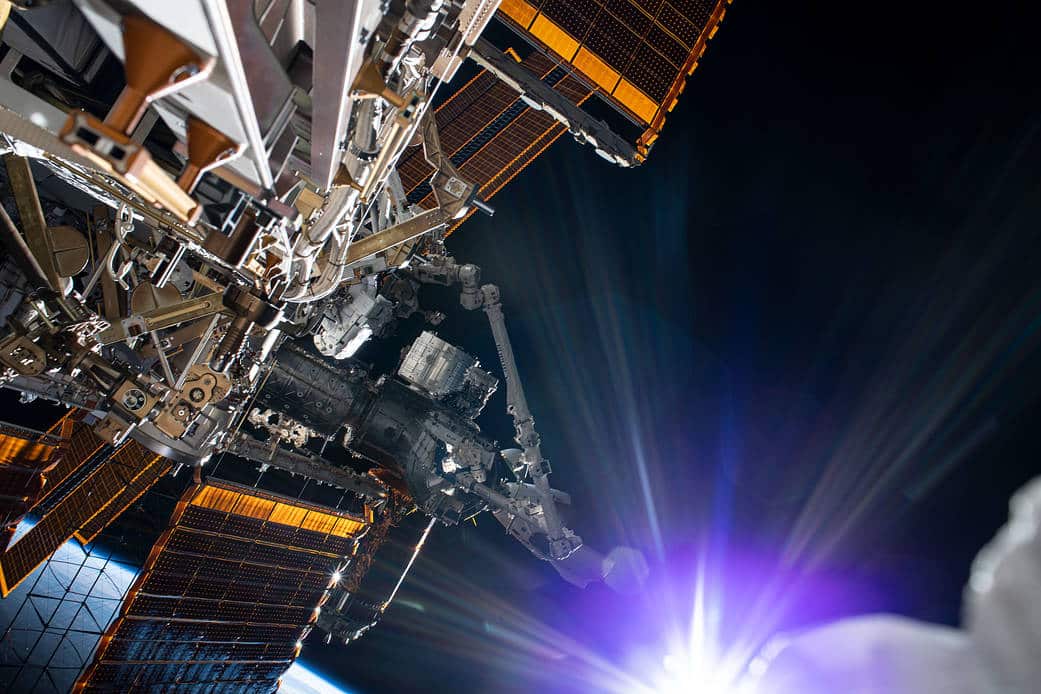Art and science are intertwined.
Ever since artists mixed minerals to create pigments to paint with, visual arts have depended on the science of optics to express themselves with a stunning range of colors. Photography was made possible by chemistry and Bach’s counterpoints are the masterful products of mathematics.
Like art, science attempts to help us understand the world around us. As we race towards a brave new world promising AI, cloning, space travel, and quantum computers have art managed to keep up with the latest technological medium? Let’s look at a few examples of modern art — gene-splicing itself with the latest techno-babble!
The Frankenstein GRID
Often regarded as the first science fiction story, Mary Shelley’s Frankenstein was published in 1818. To celebrate its bicentenary, the Stanford University School of Medicine installed an awesome work of laser art last month in Palo Alto.
The creator and curator is Charlotte Thun-Hohenstein. She calls her masterpiece, The Frankenstein GRID: Stanford’s Monster of Modern Science. It’s a 20’ by 30’ jade-green interlaced grid of lasers lit up against a liquid glycerin fog.
The Frankenstein GRID dwells on the stitches which both disfigure and bring life to Shelley’s monster. It’s a metaphor for the two divergent paths science and technology can take us, either to rapture or ruin. Without the human perspective, technology can ruin us, Thun-Hohenstein believes. If we turn our back on it like Victor Frankenstein turned his back on his creation, it will become monsters depicted in laser shows by HE-Laserscan and Tobias Zeides.
Holographic resurrection
Since the first appearance of Tupac at Coachella in 2012, Roy Orbison, or at least his hologram, has already toured the UK and is booked to play in the USA this fall.
Holograms are 2D surfaces that display very precise 3D images of real objects. They need to be illuminated by lasers or light beams to make any sense to the brain. Holograms can be viewed from different perspectives without needing special glasses. In Blade Runner 2049, a white-suited Elvis hologram appears during a bar fight. It shorts out and flickers from time to time, adding tension to the scene.
Apart from holographic equipment, all you need now for that sell-out gig is a concert stage and a live backing group. No managers, no groupies, no Elvis tributes, no ridiculous tour riders. Holograms are never late or hungover. They won’t disappear off stage unless there’s a power cut. Even live musicians are turning to holograms to lighten up the workload. ABBA is expected to tour in 2019. Gimme, Gimme, Gimme.
The robots are (have been) coming
Robots have that ominous feel to them, and artists have been trying to make peace with this long before Boston Dynamic and Black Mirror unleased their robotic canines on us.
Back in 2006, U.S. robotic bio-artist, Ken Rinaldo, of Ohio State University made some Autotelematic spider bots which have sensors and can make creepy bird sounds and brought them to the UK. The British nervously welcomed their inauguration in 2006. Rinaldo’s arachnid art walks, chirps, and can also adopt characteristics of a bird, bat or ant. These spider bots have both long and short distance eyes and can switch on cell phones.
This year at CES 2018, Giles Walker, a British kinetic sculptor in his artwork Peepshow, made from industrial waste, shows two pole-dancing robots with CCTV cameras for heads which cleverly transfers the role of voyeur from randy barfly to the government. We’re “all living in a peepshow” is his chilling message.
Like the Frankenstein installation, new technology can invoke our deepest fears and aspirations through art.
Escaping from drones
One thing to remember is that you can’t outrun a drone. They can recognize, track, and follow us from high up in the sky or a few feet off the ground without us even noticing. But who wants to think about that sinister stuff when they can be all so pretty?
Fit them with different colored lights and you can create wonderful, vibrant light paintings in the sky. Ars Electronica Futurelab has done just that. Their performing art drones are called Spaxels, which are flown in formation to create dazzling displays of 3D imagery. Add hula hoops to those drones, as ctrl.me Robotics has done, and you get a mesmerizing robot ballet mapped to music. There’s no more vivid illustration of art merging with technology. It’s thought-provoking and beautiful at the same time.
Artificial intelligence
Would art be the same if no humans are involved? What if the technology became not just the art but the artist itself?
Last year saw the release of a music album called, ‘I AM I’ by Taryn Southern. It’s the first music album to have the chord structures and instrumentation composed entirely by AI technology. Usually, AI-generated music is edited using the human touch, but not with ‘I AM I.’ Even more remarkable, only the musical style and rhythms were tinkered with by human hands. The technology is called Amper and it uses machine learning to compose music in seconds, which means it takes longer to play it than to make it..
AI-generated art and music could soon become the new norm with humans too busy experiencing it to create any art themselves. Goodbye royalties.
What’s next?
Art and technology go robot hand in glove together. Whether society is heading for utopia or dystopia, robot art is going to be enchanting until they come after us. Until then, you can sharpen your teamwork at our future tech escape room in San Francisco!

